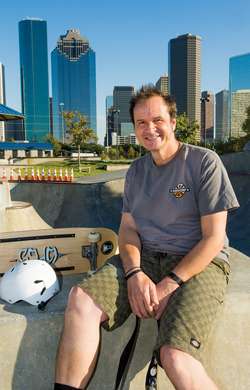Rice Professor Adrian Lenardic has turned his love of skateboarding into a way to teach science. Credit: Tommy LaVergne.
The cluster of concrete pits, ramps and hollow hemispheres perched above the banks of Buffalo Bayou, just west of downtown Houston, might look like a collection of dry backyard swimming pools or a huge surreal sculpture. But the sight of people on skateboards whizzing down the cement slopes and high up into the inner curves of the hemispheres identify its real purpose. This is the Lee and Joe Jamail Skatepark, and most of the skaters here are young people, but among the few older ones is Adrian Lenardic, who has turned his love of the sport into a way to teach science.
A Rice professor of Earth science, Lenardic started skateboarding when he was a teenager but stopped when he was a graduate student at UCLA. "There was the idea that we were just too old," he said. Instead, he took up surfing and snowboarding. But after the 30,000-square-foot Jamail Skatepark opened in 2008, he slowly got back into his old sport, and now he's a regular. "He comes to the park four or five times a week," said Aaron Cormier, a recreation assistant with the City of Houston Parks and Recreation Department, which oversees the skatepark.
Lenardic's return to skateboarding was still three years away when a sequence of events began that would eventually blend the sport with his profession as a scientist. "In 2005, I wrote a CAREER grant to the National Science Foundation," he said. "The CAREER grant asks you to define research projects that might span a career, but they know that you are an educator, so they also want you to think about ways to integrate your research into the classroom."
Lenardic's grant enabled him to create a visualization studio that can be used not only for university research and teaching, but also by K–12 students and educators, artists, and science communicators. Part of the program involves building a computer model that simulates geologic processes such as plate tectonics, surface erosion, continental collisions and planetary cooling. Another element is the creation of a workshop where advanced undergraduate and graduate students develop hands-on demonstrations of key concepts in geoscience.
"That can be drawing a picture or building a scale model you can put on a table," Lenardic said. He hopes the program will encourage students to see beyond artificial boundaries within subfields and gain a greater understanding of how scientific processes are interconnected.
As Lenardic continued tinkering, building things and taking measurements, he acquired equipment to collect on-the-fly data, such as an accelerometer, a Doppler radar unit and strain gauges. About two years ago, thinking about his newly reinvigorated hobby of skateboarding, Lenardic took his measuring gear to the skatepark. "As a curious and nerdy scientist, I brought the stuff out to measure myself," he said. "I just wanted to see how efficiently I was skating."
Some of the equipment, such as an accelerometer, was strapped to his body, while others, such as the Doppler radar unit, were set up on stands and aimed at him as he sped down the ramps or up and around the curves of the swimming pool-like bowls.
Then, an extraordinary thing happened. As he measured his performance, various people from preteens to middle-agers came up and asked what he was doing. He explained, and some of them became interested. So he helped them test themselves—for example, he used the Doppler radar unit to see how fast they were going. He asked them if they knew anything about radar and suggested that they go home and look it up. "Surprisingly, some of the kids did," he said. "That's when I realized there was potential here for educational outreach."
Provided by Rice University






















